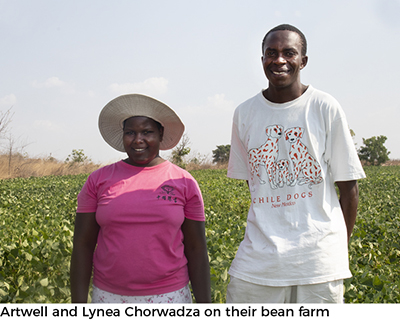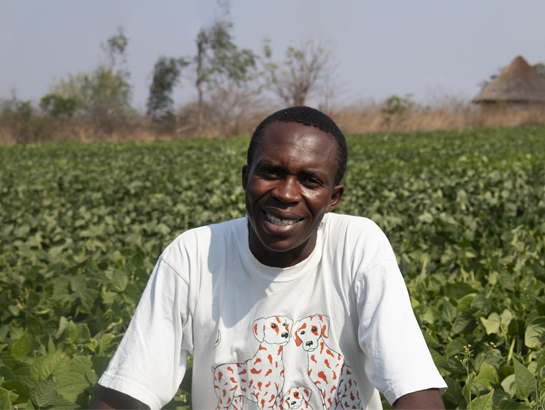Artwell Chorwadza is waiting for his planted iron beans to mature as customer demand has been booming. The 37-year-old planted the NUA45 variety of iron beans on a half hectare of his land with the help of his wife, Lynea. The couple lives in Chiweshe, Mazowe District of the Mashonaland Central Province, in Zimbabwe with their three children ages 11, 7, and 1 year, 8 months.
The Chorwadza family lives in area where there is a pronounced need for greater food security, and growing biofortified beans is one way to improve it. But few people—particularly young people—currently see a future for themselves in farming. Given pressing economic challenges, they are looking for opportunities that can provide a quicker return because they have immediate financial needs. For example, some people in the Mazowe District engage in illegal gold mining. This can be a hazardous pursuit as the miners do not have proper equipment for the work and they are working at abandoned mines that may pose dangers to them.
“I love farming and I saw a great potential in farming. That’s why I decided not to engage in mining like my fellow villagers. I am running my own company here,” said Artwell.
The couple are horticultural farmers growing mainly leafy vegetables and tomatoes. Just recently, they added iron beans to their mix of crops. Artwell looks proud as he leads the Livelihoods and Food Security Programme (LFSP) team through his healthy iron bean field. For a farmer in his late thirties, the pride comes from managing to get back into the business that many others have shunned.
The LFSP is a five-year program funded by the Government of the United Kingdom through the UK Department for International Development (DFID); it is managed by the Food and Agriculture Organization of the United Nations (FAO) and Palladium, with HarvestPlus providing technical support on biofortification. One of the objectives of the LFSP is to increase the production and consumption of a wide variety of nutritious foods among target households, including biofortified crops, namely: vitamin A orange maize, iron beans, and vitamin A orange sweet potatoes (OSP).
During the 2017/18 farming season, Artwell bought 30 kilograms (kgs) of iron beans from a fellow farmer at the Negomo Irrigation Scheme in the same district, with the intention to grow his own seed. He grew the seed on 0.1 hectare and harvested 60 kgs of dried beans. From the harvest, the family decided to keep 10 kgs for consumption.
Said Lynea: “Iron beans are good for women of child-bearing age like me, and for pregnant and breastfeeding mothers and children to consume. Iron is needed by the body for healthy blood, and it is essential for physical health, mental well-being and brain development in children.”
Her ability to interpret the health benefits of her products is valuable, given that nutrition education remains low among most Zimbabweans. The bean variety being grown by the Chorwadzas and promoted under LFSP has higher content of iron as well as zinc than other bean varieties grown in the country.
During the 2018/19 farming season, the couple grew 50 kgs of iron beans on 0.5 hectare, and harvested 1,250 kgs of dried beans. They kept 250 kgs for consumption and sold 1000 kgs at USD 35 per 20 kg, and received USD 1750 in income.
 “We managed to sell most of our beans and like always, our family`s health is our number one priority, so we kept some of it to eat. We used the profit to pay school fees for our children and to buy new clothes for the whole family. I was also able to buy inputs and seed for tomatoes, butternuts, and rape,” said Artwell.
“We managed to sell most of our beans and like always, our family`s health is our number one priority, so we kept some of it to eat. We used the profit to pay school fees for our children and to buy new clothes for the whole family. I was also able to buy inputs and seed for tomatoes, butternuts, and rape,” said Artwell.
Having seen the potential in this young farmer, a private company, Food Queens, contracted Artwell to grow iron bean seed in the current 2019/20 season. The company will pay USD 900 per ton.
More than 65 percent of the Zimbabwean population live in rural areas and are food insecure, especially due to droughts. The population experiences fluctuating levels of malnutrition, including vitamin and mineral malnutrition. Studies done in Zimbabwe with children ages 6 to 59 months have shown that: one in four children has vitamin A deficiency; about 72 percent are living with iron deficiency; and one in three have iron deficiency. For Zimbabwean women of reproductive age, one in four have vitamin A deficiency, six in ten have iron deficiency, while 26 percent are anemic.
Beans are a staple for the majority of Zimbabweans. That means a lot of potential customers and income for farmers like Artwell and other bean farmers in Zimbabwe. In addition, promoting the production and consumption of iron beans will help in the fight against micronutrient malnutrition in the country.
